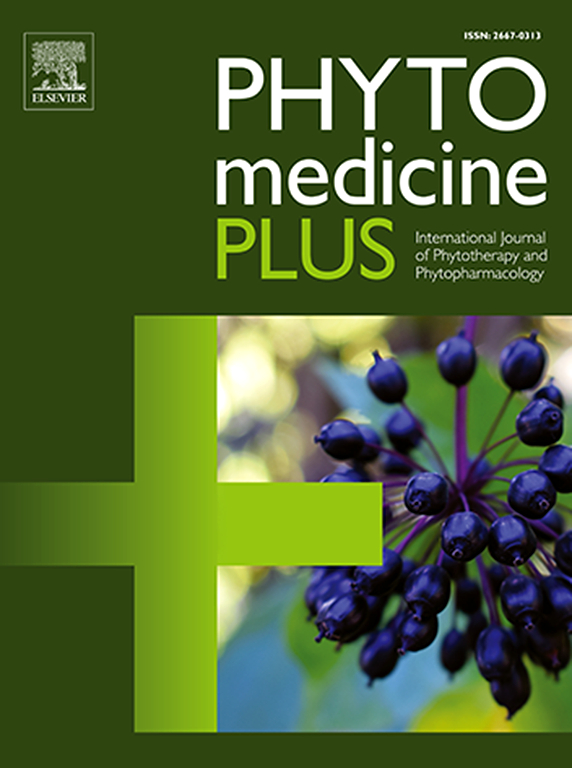Antioxidant, anti-glycation and hypoglycemic potentials of Acmella uliginosa: A probable candidate for the amelioration of diabetes mellitus
Q3 Pharmacology, Toxicology and Pharmaceutics
引用次数: 0
Abstract
Objective
Acmella uliginosa, widely distributed across Asia, has long been used traditionally for various purposes. This study explored the pharmacological potential of its whole plant and flower extracts, focusing on antioxidant, anti-glycation, and in vivo anti-diabetic activities.
Materials and methods
The methanolic extracts of A. uliginosa whole plants and flowers were analyzed for flavonoid, phenolic content, and total antioxidant capacity, expressed as gallic acid, rutin, and ascorbic acid equivalents, respectively. Antioxidant activity was assessed using DPPH and ABTS assays. The inhibitory effect on AGE formation was evaluated by fluorometric analysis, along with protein carbonyl content and thiol group modifications in glycated BSA. The antidiabetic potential of the extracts was tested through the OGTT, and hypoglycemic activity both in normal mice, and alloxan-induced diabetic mice.
Results
In antiglycation studies, A. uliginosa flower extract showed superior inhibition of AGEs formation compared to the whole plant extract, and its effect at 4 mg/mL was comparable to aminoguanidine. The flower extract also effectively reduced protein carbonyl content and preserved thiol group levels in a dose-dependent manner, indicating its strong protective effect against protein damage caused by oxidative stress. It exhibited higher flavonoid content and stronger antioxidant activity than the whole plant extract. In vivo studies confirmed the antidiabetic potential of both extracts, with significant reductions in blood glucose levels in OGTT and hypoglycemic tests. After seven days, the flower extract lowered blood glucose in diabetic mice to near-normal levels, similar to glibenclamide.
Conclusion
Therefore, the plant A. uliginosa might be a promising herbal medicine to prevent diabetes and its associated complications by inhibiting AGEs formation, lowering blood glucose level, and reducing oxidative damage of proteins.

紫花苜蓿的抗氧化、抗糖化和降糖潜能:改善糖尿病的可能候选物
【目的】紫花苜蓿广泛分布于亚洲各地,传统上长期用于各种用途。本研究探讨了其全株和花提取物的药理潜力,重点研究了其抗氧化、抗糖化和体内抗糖尿病活性。材料与方法对木犀草全株和花的甲醇提取物进行了类黄酮含量、酚类含量和总抗氧化能力的测定,分别以没食子酸、芦丁和抗坏血酸当量表示。采用DPPH和ABTS测定抗氧化活性。通过荧光分析评估对AGE形成的抑制作用,以及糖化BSA中蛋白质羰基含量和巯基修饰。在正常小鼠和四氧嘧啶诱导的糖尿病小鼠中,通过OGTT和降糖活性测试了提取物的降糖潜力。结果在抗糖化研究中,乌里木花提取物对AGEs形成的抑制作用优于全株提取物,其浓度为4 mg/mL时的抑制作用与氨基胍相当。花提取物还能有效降低蛋白质羰基含量,并保持巯基水平,且呈剂量依赖性,表明其对氧化应激引起的蛋白质损伤具有较强的保护作用。与全株提取物相比,其黄酮含量较高,抗氧化活性较强。体内研究证实了这两种提取物的抗糖尿病潜力,在OGTT和低血糖试验中显著降低血糖水平。7天后,花提取物将糖尿病小鼠的血糖降至接近正常水平,类似于格列本脲。结论乌里木草可能具有抑制AGEs形成、降低血糖水平、减少蛋白质氧化损伤等作用,是预防糖尿病及其相关并发症的理想草药。
本文章由计算机程序翻译,如有差异,请以英文原文为准。
求助全文
约1分钟内获得全文
求助全文
来源期刊

Phytomedicine Plus
Medicine-Complementary and Alternative Medicine
CiteScore
3.70
自引率
0.00%
发文量
178
审稿时长
81 days
期刊介绍:
 求助内容:
求助内容: 应助结果提醒方式:
应助结果提醒方式:


